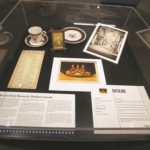Culinary Arts Museum at Johnson & Wales University
Whether you are a student, professional chef, collect kitchenalia or just appreciate history, cooking and food, the Culinary Arts Museum in Providence, Rhode Island, should be at the top of your list for a visit. Located on the Harborside Campus of Johnson & Wales University, this 25,000-square-foot teaching museum has the mission to preserve and interpret culinary and hospitality heritage for both JWU students and the public at-large.
The museum’s origin goes back to a 1979 donation of 7,500 cookbooks, some dating to the 1600s. The collection continues to grow under the stewardship of Director and Curator Richard J.S. Gutman. Today, there are roughly 200,000 items, including menus, appliances, advertising, food packaging and branding, signage, photographs, tools and instruments from centuries past, historical documents, the work of students and instructors, and iconic items from famed chefs. There are even buildings, building fragments and vehicles inside the museum. While seemingly all categories under the culinary umbrella are represented, it is the displays and ever-changing special exhibits culled from this collection that tell the bigger story.
“Our goal is to inform our students about the culinary past so they can be better prepared to shape the food landscape of the future,” shares Gutman. “Unending stories are realized through these exhibits.”
Walk into the museum and immerse yourself in diner history with vignettes that follow the evolution of the 19th-century horse-drawn lunch wagons into the classic American diners that transformed the 20th century dining-out experience. Lit by the glow of the original Moody’s Diner neon sign, there is a place to sit at a booth or on a stool at the soda fountain, with a countertop jukebox and daily specials on view. Part of the exhibition includes the Ever Ready Diner, an actual 15-stool eatery built in 1926 by the Worcester Lunch Car Company. This will give you the opportunity to walk inside and appreciate the tight quarters and aesthetic design of these iconic roadside restaurants.
In another area, Stoddard’s Stagecoach Tavern lets visitors step back into an 1833 tap room where travelers and locals were served in Stoddard, New Hampshire, until 1952. Taverns were the first commercial establishments in America to provide food and drink, giving them an important place in American culinary history, in addition to being gathering places in their communities.
“Country Fair to Culinary Olympics” is an exhibition that looks at cooking competitions as viewed through the prism of fairs and expositions. The country fair section features a midway and highlights the food contests, home canning, and culinary aspects of these ever-popular annual gatherings.
The museum’s “Food on the Move” exhibit illustrates the dining experience on planes, trains, and ocean liners with photographs, advertisements, menus, service items, and other artifacts reminiscent of a refined era of travel and dining, long gone but not forgotten.
Of an even more historical nature is the “Culinary Beginnings” gallery, which highlights some of the tools and implements used centuries ago to prepare food and transfer it from fire to table and then from plate to mouth. The exhibit celebrates the culinary heritage of the Chinese and Koreans, the peoples along the Silk Road, the ancient Egyptians, and the Greeks and Romans of the Classical Age.
The Museum’s newest exhibit tells the story of Post Foods and its evolution from a cereal company with a handful of products to the largest U.S. food company. On display are products, advertising, photographs and packaging that illustrate this fascinating story.
What’s next? Gutman shares that a “Major, Minor, Miniature” exhibit is in the works. This will showcase the changing technology of major and minor appliances and kitchen items, and their miniature counterparts.
From a wall displaying a range of open hearth cooking tools to display cases with early examples of such popular kitchen appliances as the toaster, there’s something appetizing to look at and experience in every corner of this unique museum and its collection.
For more information and to plan a visit to the Culinary Arts Museum, go to www.culinary.org.








Related posts: